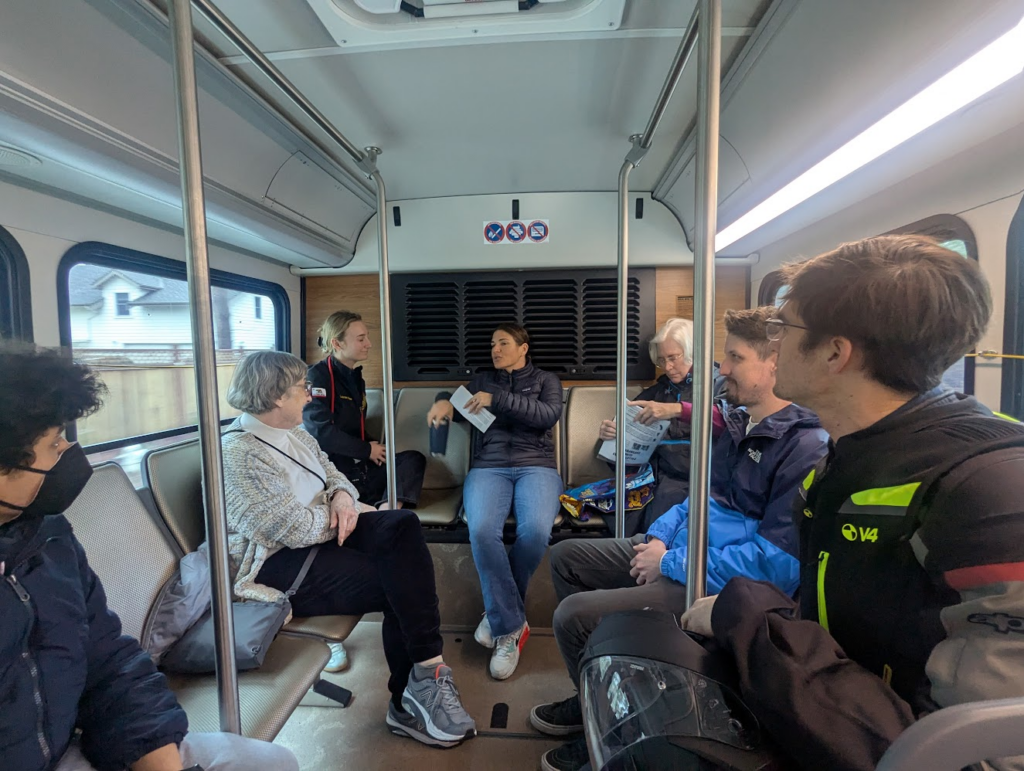By Noor Rizvi —
A group of transit advocates organized by Transbay Coalition were thrilled to have State Assemblymember Rebecca Bauer-Kahan join us for a bus ride-along last week! In a time when politicians and decision-makers seem disconnected from the public, one of the best ways to help elected officials truly understand the transit rider experience is to have them go for a transit ride and get some first-hand experience themselves.
For some Californians, it is too inconvenient, slow, or expensive to use transit to get where they need to go. For many Californians, transit is simply not an option because there is no bus at all. And right now, the transit agencies that many Californians rely on are on the cusp of slashing service due to federal support running out. The good news is that our elected representatives have the ability to make transit frequent, easy, accessible, and affordable for all! But too often, improving transit is simply not a priority for them. When elected officials do not regularly take transit, the real-world impacts their decisions have on transit riders can feel like an academic matter rather than the physical, visceral – and often high-stakes – issue that it is.
Our group consisted of seniors from Rossmoor, a high school student from Dublin, a young professional who newly moved to Walnut Creek, Livermore City Councilmember Steven Dunbar, the social justice group Public Advocates’ Laurel Paget-Seekins, and Transbay Coalition’s Co-Founder Carter Lavin. We met the Assemblymember and her staffer Lauren Howe at the Walnut Creek BART station and took the County Connection 21 route to the Alamo Plaza shopping center and back. Along the trip, we saw many people get on and off the bus on their way to work, doctors appointments, and running errands.
On the hour-long adventure, we had insightful and productive conversations on the issues affecting transit riders and our communities as a whole. We talked about things like:
- How many East Bay residents lack adequate transit access and significant portions of Contra Costa County lack any public transit service, because agencies don’t have the funding they need to operate buses there. With adequate funding, transit can connect more people to the places they need to go, especially seniors, students, and others who depend on transit.
- In many cases, transit lines have limited service hours, forcing people to drive, endure significantly longer trips, or only take trips during certain periods. For example, on I-680, express buses only run during rush hour. The only transit service outside of those periods is a slow local bus, creating a 90 minute trip from Walnut Creek to Dublin, meanwhile drivers make the trip in 30. In Rossmoor, a large senior community in Walnut Creek, a shuttle connecting to Downtown Walnut Creek only runs on Tuesdays, Wednesdays, and Thursdays, from 10am to 2pm. This limited service means that transit dependent seniors miss out on important opportunities, such as doctor\’s visits. If transit agencies were fully funded, they could run transit service more frequently, and for longer. On the 680, there’s already a plan for frequent, all-day express bus service, but it lacks funding.
- Access to public transit for youth improves school attendance, connects young people to jobs and opportunities, and encourages them to continue riding transit, even after becoming eligible to drive. For example, all public transit in Washington state, including buses, trains, state-funded Amtrak service, and ferries, has been free for riders under 19 for years, which increased youth transit ridership to 16.5 million in 2023. San Francisco’s Muni offers free rides to people under 19, and Denver’s transit system allows anyone under 20 to ride for free. A statewide program to make all transit free for young Californians would reduce school absences and connect youth to family, friends, and opportunities.
- As we waited for the return bus at a leaky bus shelter, we chatted about how bus shelters and safe places to wait are a huge part of a welcoming transit experience. Many bus stops lack adequate shelters, signage, or safe access routes. Improved payment systems are also essential to providing good transit service, especially systems that are accessible to riders who don’t speak English. And, once again, if transit agencies were properly funded, transit riders would be treated better.
While transit ridership in many parts of the Bay Area has largely recovered to pre-COVID levels, with SamTrans and VTA nearing 100% of pre-COVID ridership, and many Muni bus lines experiencing over 110% of pre-COVID ridership, revenue has not, due to changes in travel patterns and other financial conditions. Without proper funding, public transit agencies will soon be forced to cut service, severing vital links to workplaces, schools, grocery stores, and hospitals. That’s why it’s essential that transit remains funded and supported. We were pleased to see that Rebecca Bauer-Kahan was ready to listen to our concerns. She came in with an open mind and understood the importance of public transit to communities. We urged her to support a regional transit funding measure for the Bay Area, which if passed would generate over $1 billion to transit agencies throughout the Bay, and a state budget proposal for $2 billion to be allocated to transit operations throughout the state of California.
Securing transit funding requires everyone to step up to support our community. Contact your representatives to talk about the importance of transit funding here. If you would like to organize a ride-along with your elected officials, or want to get involved with supporting public transit, shoot us an email at info@transbaycoalition.org.
Happy riding!

